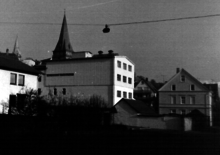Brauns-Heitmann
| Brauns-Heitmann
|
|
|---|---|
| legal form | GmbH & Co. KG |
| founding | 1st October 1969 |
| Seat |
Warburg , Germany |
| management | Stefan Kremin, Helmut Kokenbrink (Managing Director) |
| Branch | chemistry |
| Website | www.brauns-heitmann.de |
Brauns-Heitmann is the name of a chemical company in Warburg . The object of the company is the manufacture and sale of food colors , textile dyes, impregnation agents , decolorizers, stain removers, stain removers, Easter and Christmas items .
history
The history of Brauns-Heitmann goes back to two companies that initially operated separately, the Brauns company in Quedlinburg and the Heitmann company in Cologne . Both originated in the early days and dealt with the production and sale of artificial aniline dyes for domestic use, which had been invented shortly before .
Wilhelm Brauns company
In 1874, the pharmacist Wilhelm Brauns (1841–1914) began producing fabric paints for home dyeing in his pharmacy in Brome . The great demand led him to devote himself entirely to colors at the end of the 1870s. In Quedlinburg he built with his future partner Dr. Josef Weller set up an aniline paint factory, Wilhelm Braun's paint factory . On May 4, 1895, he had his trademark , Braun's "crown with bow" protected under trademark law. On the Brauns price list from 1908 there were colors for fabrics , leather , candles , floor polishes , wood , moss , grass , flowers , soaps , and food and beverages such as butter, cheese, juices and liqueurs. The products were sold through pharmacies and drug stores , but industry was also supplied. Brauns builds branches and subsidiaries in Amsterdam , Milan , Warsaw and Zurich . In 1920 Quedlinburg employed 370 people. The product range has been expanded to include agents for impregnating, removing stains and bleaching. Brochures were offered in 30 languages. In 1930 the still existing factory buildings at Harzweg 12 were built according to plans by Hermann Baranke . After 1945 the company was divided. While production in Quedlinburg was only carried out on a smaller scale, Brauns first founded a new aniline paint factory in Munich, which was sometimes called Wilbra Chemie after the founder's initials . In 1952 the company headquarters and production were relocated to Bad Aibling .
Company Gebrüder Heitmann
In 1884 the brothers Fritz and Nikolaus Heitmann founded the “Gebr. Heitmann, Cologne, factory of non-toxic paints ”. You will initially focus on the home dyeing market. For the traditional custom of coloring eggs for Easter, they developed synthetic egg dyes that were considerably more colorful and brilliant than the natural colors used until then . On January 4, 1896, they registered their trademark, a “fox head in a star” with the initials G. H. for Gebrüder Heitmann. The business developed so successfully that another location was established in what was then the Russian city of Riga before the First World War . In 1928 a branch in Barcelona followed . After the destruction of the Cologne production facilities in World War II , the successors and cousins of the company's founders moved the company and their place of residence to Warburg in Westphalia in 1943. A new factory was gradually built on the site of the former Old Town brewery , Klockenstrasse 8.
Merger to form Brauns-Heitmann
At the end of the 1960s, business became more difficult as people increasingly preferred to buy ready-made products rather than dyeing fabrics and Easter eggs at home. On October 1, 1969, the traditional companies that had previously been competing merged to form Brauns-Heitmann GmbH & Co. KG . The company headquarters in Bad Aibling and Warburg both remained initially.
In 1971 Brauns-Heitmann developed a new division, which quickly developed into a major sales driver: decorative items for every season. In addition to drugstores, it was also sold through food retailers , and later also in hardware stores . In 1977, with "Simplicol" , the company brought out the first boil-proof textile dyes for use in the washing machine. In 1980 the company had around 140 employees. The new business areas made space in the old town of Warburg too narrow. With the support of urban development funding , operations were outsourced to the Lütkefeld industrial park in Warburg from 1981 to 1983 and the old area was given residential development.
In 1990, after unsuccessful reprivatisation talks with the Modrow administration , the former Wilhelm Brauns paint factory in Quedlinburg was re -established as Wilbra-Chemie GmbH by the Treuhandanstalt on July 1st . Before that, the company had been nationalized step by step from 1959 to 1972 and, as VEB Farb-Chemie Quedlinburg, most recently produced wood stains and adhesives . In 1993 the Quedlinburg factory was returned to the Braun heirs on January 1st. An integration into the Brauns-Heitmann company did not take place. In the same year the Bad Aibling location was closed and all Brauns-Heitmann activities were now concentrated on the Warburg location.
In 1998 Brauns-Heitmann took over the companies Annen-Chemie and Coturel . A full service in the field of decoration and egg colors was introduced by equipping the sales displays in Warburg, delivering them to retailers and maintaining them in the store by service employees.
In 2004 the production of Wilbra-Chemie in Quedlinburg was stopped, since then the listed buildings have been empty.
In 2007, with the acquisition of Krebs & Sohn, the decoration division was further expanded, this time in the area of high-quality Christmas tree glass decorations.
Web links
Individual evidence
- ↑ Imprint
- ↑ Guide through Quedlinburg , publisher: Selmar Kleemann on behalf of the Quedlinburg Municipal Transport Office, 1920, page 36
- ↑ Silke Garenfeld, Elmar Nolte: Redevelopment Warburg-Altstadt, study at the TH Darmstadt, 1981, p. 39
- ↑ Is there another fire devil in Quedlinburg? , Mitteldeutsche Zeitung from April 19, 2010
- ↑ Urban Exploration - Lost Places - Marodes.de - Beauty of Verfall, accessed on December 27, 2017




